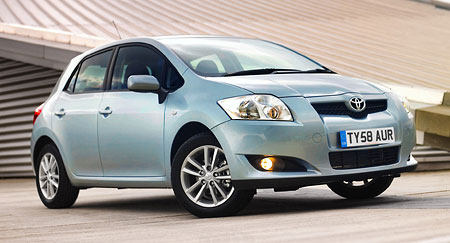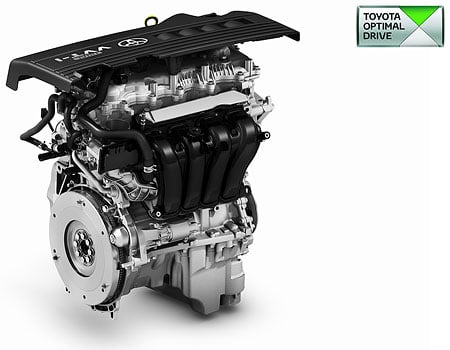Toyota has replaced the 1.4 litre VVT-i engine (4ZZ-FE) in the Toyota Auris with a new 1.33 litre Dual VVT-i engine (1NR-FE) that produces more power, more torque, more mileage, less CO2 emissions, yet has a smaller displacement and also weighs 13kg less despite having a more complicated Dual VVT-i drivetrain, thanks to pistons that are 36% lighter among other improvements. It’s also more compact, and Toyota claims it is the same size as the inline-3 1.0 litre VVT-i engine.
The new engine also has stop-start capability, which automatically stops the engine when the car is stationary, the transmission is in neutral and the driver’s foot is off the clutch pedal. When the driver presses the clutch, the engine is restarted, and Toyota claims a potential fuel savings and CO2 reduction of up to 15% thanks to this.
For a smoother restart, Toyota says this new engine is 9dB quieter and 0.3 seconds quicker to start compared to the outgoing 1.4 litre engine.
The following is a comparison table between the two engines.
| 1.33L Dual VVT-i | 1.4L VVT-i | |
| Engine Code | 1NR-FE | 4ZZ-FE |
| Displacement | 1,329cc | 1,398cc |
| Power | 101hp @ 6,000rpm | 97hp @ 6,000 |
| Torque | 132Nm @ 3,800rpm | 130Nm @ 4,400rpm |
| Bore | 72.5mm | 79.0mm |
| Stroke | 80.5mm | 71.3mm |
| Compression | 11.5:1 | 10.5:1 |
| Combined economy | 48.7mpg | 40.9mpg |
| CO2 emissions | 135g/km | 163g/km |
With the new engine also comes a new 6-speed manual transmission with ratios to match the new torque curve. Both the 5th and 6th gear are overdrive gears for a reduced cruising engine RPM during highway driving. Toyota says this new transmission can handle more torque than the outgoing 5-speed unit and is 11% smaller and has 15% less components despite having one extra gear ratio.
All these improvements come with a price of course. The new Auris 1.33 litre models are on average about £200 more expensive than the outgoing 1.4 litre models.

Looking to sell your car? Sell it with Carro.





























AI-generated Summary ✨
Comments focused on the new Toyota 1NR-FE 1.33L Dual VVT-i engine highlight its impressive technical aspects, such as longer stroke, good torque, and fuel efficiency, with some users expressing admiration for Toyota's technological advancement. There is curiosity about why the engine is named 1.33L instead of 1.3L, which is explained through technical parameters like displacement. Several comments compare this engine to Proton's Campro, noting Proon's engines are tuned for lower-quality fuels or differ in technology, sometimes questioning the engine's compatibility with Malaysian fuel standards. A few users express skepticism about local fuel quality and Proton’s engine refinement, while others hope for the engine's eventual availability locally. Overall, the comments reflect excitement about Toyota’s engineering progress, mixed with discussions on fuel quality and regional vehicle technology.